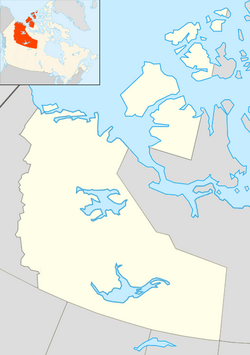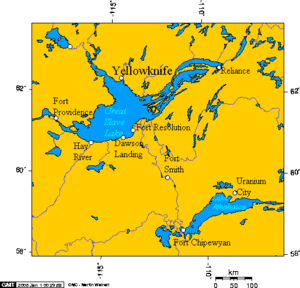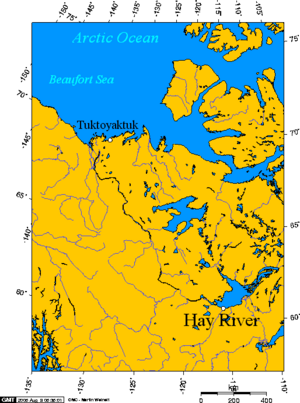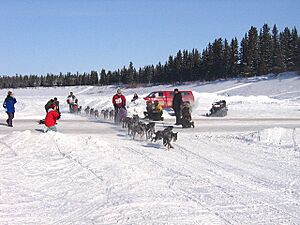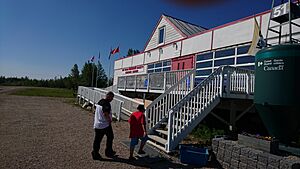Hay River, Northwest Territories facts for kids
Quick facts for kids
Hay River
Xátł'odehchee
Xatlodehchee
|
|
|---|---|
|
Town
|
|
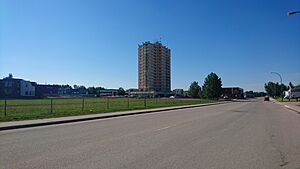
The High Rise dominates the skyline
|
|
| Motto(s):
Hub of the North
|
|
| Country | Canada |
| Territory | Northwest Territories |
| Region | South Slave Region |
| Constituency | Hay River North Hay River South |
| Census division | Region 5 |
| Incorporated (town) | 27 June 1963 |
| Area | |
| • Land | 122.4 km2 (47.3 sq mi) |
| • Population centre | 3.16 km2 (1.22 sq mi) |
| Elevation | 165 m (541 ft) |
| Population
(2021)
|
|
| • Total | 3,169 |
| • Density | 25.9/km2 (67/sq mi) |
| • Population centre | 2,380 |
| • Population centre density | 752.8/km2 (1,950/sq mi) |
| Time zone | UTC−07:00 (MST) |
| • Summer (DST) | UTC−06:00 (MDT) |
| Canadian Postal code |
X0E 0R0 – 0R9/1G1 – 1G5
|
| Area code(s) | 867 |
| Telephone exchange | 874/5 |
| – Living cost | 132.5 |
| – Food price index | 121.3 |
| Climate | Dfc |
| Website | www.hayriver.com |
| Sources: Department of Municipal and Community Affairs, Prince of Wales Northern Heritage Centre, Canada Flight Supplement 2013 figure based on Edmonton = 100 2015 figure based on Yellowknife = 100 |
|
Hay River is a town in the Northwest Territories, Canada. It is often called "the Hub of the North." The town sits on the south shore of Great Slave Lake, right where the Hay River flows into it.
Hay River is divided into two parts: a new town and an old town. The Hay River/Merlyn Carter Airport is located between them. This town is part of the South Slave Region. It is one of two places in the region that has a main regional office.
Contents
History of Hay River
People have lived in the Hay River area for a very long time. First Nations people, known as the Long Spear people, used this land as far back as 7000 BC.
Early Settlements and Missions
The first buildings in the area were set up by the Hudson's Bay Company in 1868. A Roman Catholic Mission followed in 1869. An Anglican Mission was built in 1894.
However, the town's own history says the first lasting settlement was on what is now the Katl'odeeche First Nation Reserve. This happened between 1892 and 1893. Chief Chiatlo and his group built log cabins and brought dairy cows. The Anglican Mission came in 1893 at Chief Chiatlo's request. The Roman Catholic Mission and the Hudson's Bay Company arrived later.
Growth and Development
Over time, a school, a health centre, and the Royal Canadian Mounted Police (RCMP) came to Hay River. During the Canol Road project, the United States Army Corps of Engineers built an airport runway on Vale Island.
In 1948, the Government of Canada built a gravel road, now called the Mackenzie Highway. This road connected Hay River to southern Canada. It was the first community in the Northwest Territories to have an all-season road link. This led to a big economic boost. Hay River became a major trucking hub, and a commercial fishing industry started. In 1949, the community formed its first local government.
Transportation Hub
In 1959, the Northern Transportation Company Limited made Hay River its main base. This base became a key starting point for the yearly sealift. This is when supplies are shipped by boat along the Mackenzie River to communities in the Arctic Ocean.
In 1964, a big flood hit Vale Island, where the town was originally located. Because of this, the town was moved to its current spot further upstream.
Also in 1964, the Mackenzie Northern Railway was built. This railway connects Hay River to the rest of Canada's railway system through Canadian National Railway in Edmonton. This makes Hay River the northernmost point in North America connected to the main railway network.
Major Events and Challenges
In 1978, Hay River, along with the nearby community of Pine Point, hosted the fifth Arctic Winter Games. This is a big sports and cultural event for northern regions.
Hay River has faced challenges with flooding. In 2022, severe flooding caused by ice breaking up on the Hay River forced everyone to evacuate. The town has also flooded in 1963, 2008, 2009, and 2020.
On August 25, 2023, the entire town had to evacuate again. This time, it was due to the 2023 Canadian wildfires that were spreading across the Northwest Territories.
Community Services
Hay River has many important services for its residents.
Health and Safety
The town has the H.H. Williams Memorial Hospital, which provides full hospital services. There is also a women's shelter, a dental clinic, and an ambulance service. The local RCMP detachment has eight officers. The South Mackenzie Correctional Centre is also located here.
Shopping and Banking
You can find two grocery stores in Hay River, including the Northern Store. There are also branches of the Canadian Imperial Bank of Commerce and the Royal Bank of Canada. A Home Hardware store is available for home improvement needs.
Airlines and Travel
Several airlines serve Hay River. Buffalo Airways, a local airline, offers flights to Yellowknife and charter services. First Air also has scheduled flights to Yellowknife. Northwestern Air provides scheduled service to Edmonton and Fort Smith. Other companies offer charter flights and helicopter services.
Places of Worship
Hay River has a variety of religious services. There is a Catholic church, an Anglican/Grace United church, a Baptist church, a Pentecostal church, and a Community Fellowship in the new town. A Jehovah's Witness Kingdom Hall is located along the highway. On the Katl'odeeche First Nations Reserve, there is a small Catholic church and a larger Pentecostal church.
Education in Hay River
Hay River has four schools. Three of these are managed by the South Slave Divisional Education Council (SSDEC).
- Harry Camsell K-3 School: This is a primary school for students from kindergarten to Grade 3.
- Princess Alexandra Middle School: Named after Princess Alexandra, The Honourable Lady Ogilvy, who opened it in 1967. This middle school serves students from Grade 4 to Grade 7.
- Diamond Jenness Secondary School: Named after scientist Diamond Jenness, this high school opened in 1973. It serves students from Grade 8 to Grade 12.
The fourth school, École Boréale, is a French-language school. It opened in 2005 and teaches students from PK4 (pre-kindergarten) to Grade 12. The town also has a Community Learning Centre and a Career Centre.
Media and Communication
Hay River has its own local media, including radio, television, and a newspaper.
Radio Stations
| Frequency | Call sign | Branding | Format | Owner | Notes |
|---|---|---|---|---|---|
| FM 93.7 | CBDJ-FM | CBC Radio One | Talk radio, public radio | Canadian Broadcasting Corporation | Rebroadcasts CFYK-FM from Yellowknife |
| FM 100.1 | CJCD-FM-1 | 100.1 True North FM | Adult contemporary | Vista Broadcast Group | Rebroadcasts CJCD-FM from Yellowknife |
| FM 101.9 | CHRR-FM | CKLB Radio: The Voice of Denendeh | Community radio | Native Communications Society of the Northwest Territories | First Nations community radio; rebroadcasts CKLB-FM from Yellowknife |
| FM 107.3 | CKHR-FM | Hay River Community Radio | Community radio | Hay River Community Service Society |
CKHR-FM 107.3 is a local community radio station. It is the only station in Hay River with its own studios. Other radio stations here simply repeat broadcasts from Yellowknife.
Television Services
The Hay River Community Service Society also manages television broadcasting. This service is paid for by property taxes. Channels 2–5, 7, and 8–13 re-broadcast Canadian and US channels. These include a local community channel (CIHC-TV channel 5), a French-language channel (CH4435 channel 8), and a channel for Indigenous peoples (CH4160 channel 12).
Local Newspaper
The Hub is a weekly newspaper. It is published by Northern News Services. The paper is available in Hay River and other nearby communities.
Climate and Weather
Hay River has a subarctic climate. This means it has long, cold winters and short, cool summers. Summer usually lasts for about three months. Even in winter, temperatures can sometimes rise above 10 degrees Celsius.
Rainfall averages about 217.4 mm per year, and snowfall averages 138.9 cm. From December to January, there are often days when the wind chill makes it feel colder than -30 degrees Celsius. At these temperatures, frostbite can happen quickly.
The hottest temperature ever recorded in Hay River was 36.7 degrees Celsius on August 9, 1981. The coldest temperature ever recorded was -52.2 degrees Celsius on January 23, 1906.
| Climate data for Hay River (Hay River/Merlyn Carter Airport) WMO ID: 71935; coordinates 60°50′23″N 115°46′58″W / 60.83972°N 115.78278°W; elevation: 164.9 m (541 ft); 1981–2010 normals, extremes 1893–present |
|||||||||||||
|---|---|---|---|---|---|---|---|---|---|---|---|---|---|
| Month | Jan | Feb | Mar | Apr | May | Jun | Jul | Aug | Sep | Oct | Nov | Dec | Year |
| Record high humidex | 10.6 | 12.9 | 14.6 | 25.8 | 31.1 | 35.1 | 44.6 | 39.8 | 32.2 | 25.4 | 12.8 | 11.2 | 44.6 |
| Record high °C (°F) | 10.7 (51.3) |
13.9 (57.0) |
15.6 (60.1) |
26.0 (78.8) |
33.3 (91.9) |
34.0 (93.2) |
35.6 (96.1) |
36.7 (98.1) |
31.7 (89.1) |
25.6 (78.1) |
15.0 (59.0) |
14.4 (57.9) |
36.7 (98.1) |
| Mean daily maximum °C (°F) | −17.3 (0.9) |
−14.2 (6.4) |
−7.8 (18.0) |
2.9 (37.2) |
10.7 (51.3) |
18.0 (64.4) |
21.2 (70.2) |
19.6 (67.3) |
13.2 (55.8) |
4.1 (39.4) |
−7.7 (18.1) |
−14.4 (6.1) |
2.4 (36.3) |
| Daily mean °C (°F) | −21.8 (−7.2) |
−19.6 (−3.3) |
−13.8 (7.2) |
−2.7 (27.1) |
5.4 (41.7) |
12.5 (54.5) |
16.1 (61.0) |
14.6 (58.3) |
8.7 (47.7) |
0.5 (32.9) |
−11.6 (11.1) |
−18.8 (−1.8) |
−2.5 (27.5) |
| Mean daily minimum °C (°F) | −26.2 (−15.2) |
−24.9 (−12.8) |
−19.8 (−3.6) |
−8.1 (17.4) |
0.0 (32.0) |
7.0 (44.6) |
10.9 (51.6) |
9.5 (49.1) |
4.1 (39.4) |
−3.2 (26.2) |
−15.4 (4.3) |
−23.1 (−9.6) |
−7.4 (18.7) |
| Record low °C (°F) | −52.2 (−62.0) |
−50.6 (−59.1) |
−47.2 (−53.0) |
−40.0 (−40.0) |
−24.4 (−11.9) |
−6.1 (21.0) |
−1.7 (28.9) |
−6.7 (19.9) |
−15.6 (3.9) |
−26.1 (−15.0) |
−40.8 (−41.4) |
−51.1 (−60.0) |
−52.2 (−62.0) |
| Record low wind chill | −59 | −60 | −55 | −48 | −27 | −7 | 0 | 0 | −17 | −34 | −54 | −56 | −60 |
| Average precipitation mm (inches) | 16.4 (0.65) |
14.3 (0.56) |
14.4 (0.57) |
12.6 (0.50) |
23.3 (0.92) |
31.9 (1.26) |
43.0 (1.69) |
58.7 (2.31) |
44.6 (1.76) |
35.7 (1.41) |
24.8 (0.98) |
16.8 (0.66) |
336.4 (13.24) |
| Average rainfall mm (inches) | 0.1 (0.00) |
0.2 (0.01) |
0.2 (0.01) |
4.3 (0.17) |
18.0 (0.71) |
31.9 (1.26) |
43.0 (1.69) |
58.7 (2.31) |
43.0 (1.69) |
16.8 (0.66) |
0.9 (0.04) |
0.3 (0.01) |
217.4 (8.56) |
| Average snowfall cm (inches) | 19.2 (7.6) |
16.9 (6.7) |
16.4 (6.5) |
8.7 (3.4) |
5.2 (2.0) |
0.1 (0.0) |
0.0 (0.0) |
0.0 (0.0) |
1.5 (0.6) |
19.9 (7.8) |
30.4 (12.0) |
20.7 (8.1) |
138.9 (54.7) |
| Average precipitation days (≥ 0.2 mm) | 11.3 | 9.7 | 8.5 | 5.0 | 8.0 | 8.8 | 9.9 | 11.3 | 12.2 | 12.6 | 14.2 | 11.4 | 122.8 |
| Average rainy days (≥ 0.2 mm) | 0.1 | 0.2 | 0.2 | 2.0 | 6.7 | 8.8 | 9.9 | 11.3 | 11.9 | 6.2 | 1.0 | 0.6 | 58.9 |
| Average snowy days (≥ 0.2 cm) | 12.0 | 10.1 | 8.7 | 3.7 | 1.8 | 0.1 | 0.0 | 0.0 | 0.8 | 8.1 | 14.5 | 12.4 | 72.2 |
| Average relative humidity (%) (at 15:00) | 69.2 | 66.3 | 61.3 | 60.2 | 55.0 | 54.4 | 57.6 | 59.9 | 62.5 | 70.6 | 78.0 | 73.7 | 64.0 |
| Source: Environment and Climate Change Canada | |||||||||||||
Population and People

In the 2021 Census, Hay River had a population of 3,169 people. This was a decrease from its 2016 population of 3,528. The town covers a land area of 122.4 square kilometers.
Diverse Backgrounds
In 2016, the Indigenous population in Hay River was 1,630. This group includes First Nations, Métis, and Inuit people. Hay River is home to people from many different backgrounds.
| Panethnic group | 2021 | 2016 | 2011 | 2006 | 2001 | |||||
|---|---|---|---|---|---|---|---|---|---|---|
| Pop. | % | Pop. | % | Pop. | % | Pop. | % | Pop. | % | |
| European | 1,445 | 46.31% | 1,570 | 45.38% | 1,780 | 49.51% | 1,845 | 51.11% | 1,765 | 51.16% |
| Indigenous | 1,390 | 44.55% | 1,635 | 47.25% | 1,620 | 45.06% | 1,600 | 44.32% | 1,565 | 45.36% |
| Southeast Asian | 145 | 4.65% | 135 | 3.9% | 100 | 2.78% | 105 | 2.91% | 60 | 1.74% |
| East Asian | 80 | 2.56% | 50 | 1.45% | 40 | 1.11% | 35 | 0.97% | 40 | 1.16% |
| South Asian | 35 | 1.12% | 15 | 0.43% | 30 | 0.83% | 10 | 0.28% | 15 | 0.43% |
| African | 30 | 0.96% | 45 | 1.3% | 15 | 0.42% | 20 | 0.55% | 10 | 0.29% |
| Latin American | 10 | 0.32% | 0 | 0% | 10 | 0.28% | 20 | 0.55% | 0 | 0% |
| Middle Eastern | 10 | 0.32% | 0 | 0% | 0 | 0% | 0 | 0% | 0 | 0% |
| Other/multiracial | 10 | 0.32% | 0 | 0% | 0 | 0% | 10 | 0.28% | 0 | 0% |
| Total responses | 3,120 | 98.45% | 3,460 | 98.07% | 3,595 | 99.69% | 3,610 | 98.96% | 3,450 | 98.29% |
| Total population | 3,169 | 100% | 3,528 | 100% | 3,606 | 100% | 3,648 | 100% | 3,510 | 100% |
| Note: Totals greater than 100% due to multiple origin responses | ||||||||||
Languages Spoken
The main languages spoken in Hay River are South Slavey, Chipewyan, Michif, and English.
Notable People from Hay River
Many interesting people have connections to Hay River.
- Paul Delorey: A professional curler and former politician in the Northwest Territories.
- Brendan Green: A Canadian biathlete who competed in the 2010 Winter Olympics.
- Jane Groenewegen: A former member of the Legislative Assembly of the Northwest Territories.
- Joe McBryan (Buffalo Joe): The president and owner of Buffalo Airways, featured on the TV show Ice Pilots NWT.
- Mikey McBryan: The General Manager of Buffalo Airways and also featured on Ice Pilots NWT.
- Rob McVicar: A professional ice hockey goaltender.
- John Pollard: A politician who served in the Legislative Assembly from 1987 to 1995.
- Geoff Sanderson: A former player in the National Hockey League.
- Donald Morton Stewart: A former mayor and speaker of the Northwest Territories Legislature.
- Jelena Mrdjenovich: A world champion female featherweight boxer.
See also
 In Spanish: Hay River para niños
In Spanish: Hay River para niños


